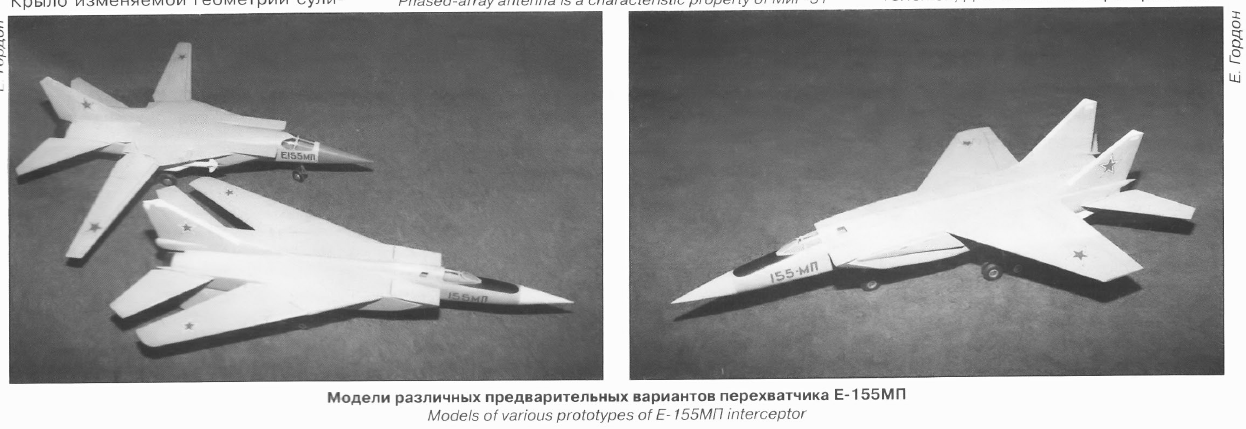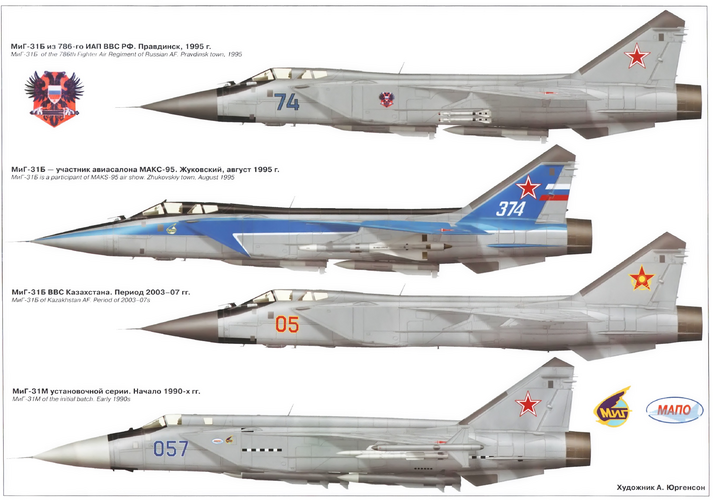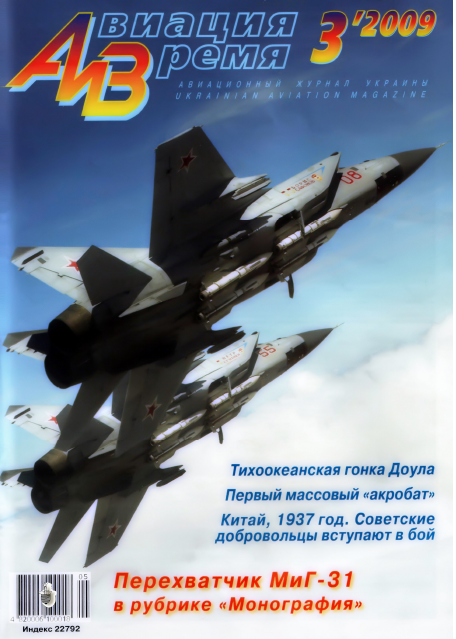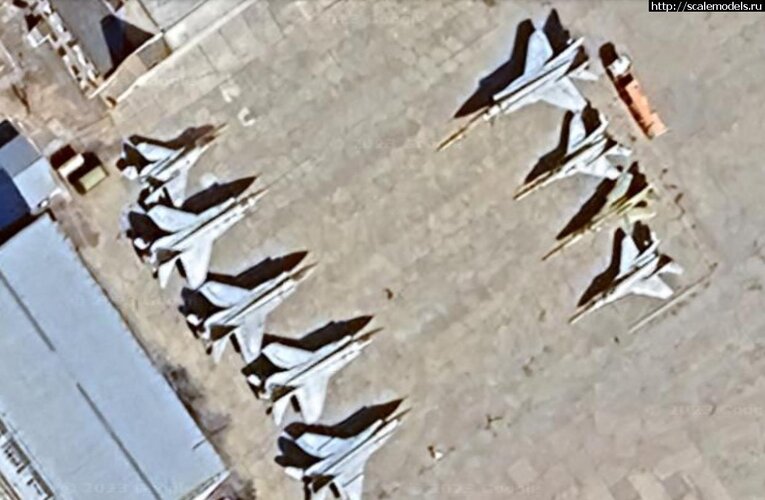You are using an out of date browser. It may not display this or other websites correctly.
You should upgrade or use an alternative browser.
You should upgrade or use an alternative browser.
Mikoyan MiG-31 Projects
ZacYates
LHX SuperTeam fanboy
- Joined
- 26 December 2012
- Messages
- 156
- Reaction score
- 136
This may be nothing, but Wikipedia has this which cites a Jane's article: "Russia plans to start development of a replacement for the MiG-31 by 2019. The aircraft will be called PAK-DP (ПАК ДП, Перспективный авиационный комплекс дальнего перехвата – Prospective Air Complex for Long-Range Interception)."Austin said:Can some one tell me if there is a follow on project to replace the Mig-31 since they may retire in 12 - 15 years after BM upgrade which is being undertaken now.
They form a good chunk of Russia Air Force AD fleet and no replacement will mean a big hole , are there any plans to replace Mig-31 interceptors in the long run ?
Info will be much appreciated.
- Joined
- 26 May 2006
- Messages
- 34,857
- Reaction score
- 15,723
- Joined
- 3 June 2006
- Messages
- 3,094
- Reaction score
- 3,949
Twitter:
Edit: The tweet has been deleted.
Attachments
Last edited:
- Joined
- 27 December 2005
- Messages
- 17,727
- Reaction score
- 26,266
Ooh, the tailless delta version at last  Air intakes seem to be ventral, not dorsal though. It's clearly Tu-144 inspired...
Air intakes seem to be ventral, not dorsal though. It's clearly Tu-144 inspired...
- Joined
- 9 October 2009
- Messages
- 21,933
- Reaction score
- 13,557
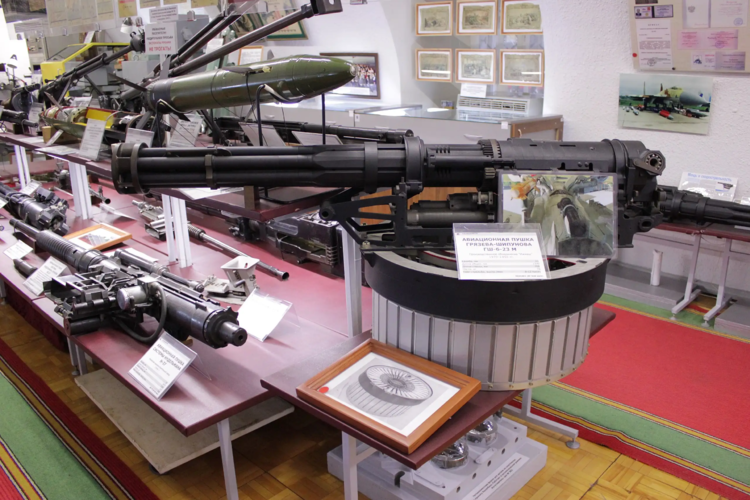
ORIGINAL CAPTION: A GSh-6-23M cannon from a MiG-31 interceptor, preserved as a museum exhibit.
However, by the mid-1970s, the Soviet Union was working on rotary cannons, similar in principle to the classic American M61 Vulcan. While the U.S. gun fires 20mm ammunition, the Soviets always preferred larger calibers, either 23mm or 30mm. Six-barrel rotary cannons were produced in both these forms and armed the MiG-31 Foxhound interceptor and Su-24 Fencer strike aircraft (both 23mm), as well as the MiG-27 Flogger ground-attack aircraft (30mm).

Articulated Gun Pods Allowed Soviet Aircraft To Fire Backwards, Downwards, And Even Sideways
The Cold War-era gun pods were a bizarre solution for strafing ground targets, but some linger on today.
famvburg
I really should change my personal text
- Joined
- 24 July 2011
- Messages
- 386
- Reaction score
- 54
I just remembered a MiG 1.42, IIRC, drawing I have from the early ‘90s from Flight International. I’m on my phone but I’m sure it is still on my computer. It is a double delta, twin fins and canards. When I saw it back then, it made me think of a twin engined F-16XL. I wonder if it could be related to this tailless delta design.Ooh, the tailless delta version at lastAir intakes seem to be ventral, not dorsal though. It's clearly Tu-144 inspired...
Blitzer9856
ACCESS: Restricted
- Joined
- 13 August 2019
- Messages
- 48
- Reaction score
- 73
Much like the Ye-158 (the swing-wing MiG-25R), there were also plans considered for a swing-wing version of the MiG-31 (before that plane became a reality based on the Ye-155MP).
While on the drawing board, they suggested that when improving the MiG-25 with the Solovyev D30F-6 engines and among other features, that they also turn it into a swing-wing jet.

The variable-geometry wings not only improved field performance but increased onstation loiter time in certain flight modes. However, the sweep change mechanism increased empty weight and structural complexity; besides, unlike the MiG-23, the aircraft was not intended for dogfighting where 'swing wings' might confer an advantage. Hence development of this version was soon abandoned.
As you can see a couple of different nose and cockpit configurations were considered.

It was to have up to four R-33 missiles in the fuselage or four K-100s.
As it was derived from the MiG-25 and Ye-158 it was likely going to have the same performance, which would have been as follows:
Takeoff weight: 40,000 - 40,500 kg
Maximum speed:
While on the drawing board, they suggested that when improving the MiG-25 with the Solovyev D30F-6 engines and among other features, that they also turn it into a swing-wing jet.
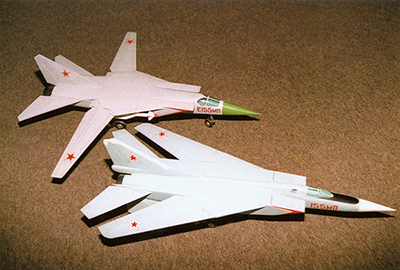
The variable-geometry wings not only improved field performance but increased onstation loiter time in certain flight modes. However, the sweep change mechanism increased empty weight and structural complexity; besides, unlike the MiG-23, the aircraft was not intended for dogfighting where 'swing wings' might confer an advantage. Hence development of this version was soon abandoned.
As you can see a couple of different nose and cockpit configurations were considered.
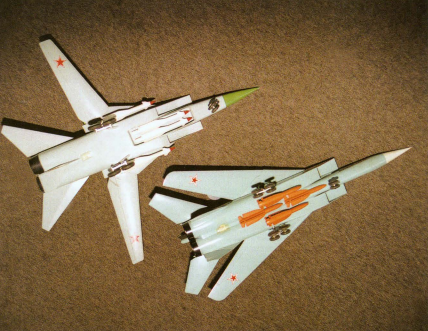
It was to have up to four R-33 missiles in the fuselage or four K-100s.
As it was derived from the MiG-25 and Ye-158 it was likely going to have the same performance, which would have been as follows:
Takeoff weight: 40,000 - 40,500 kg
Maximum speed:
- at sea level: 1,400 - 1,500 km/h
- at high altitude: 3,000 - 3,500 km/h
- at sea level: 1,600 km
- at high altitude (subsonic): 5,000 km
- at high altitude (supersonic): 2,500 km
Last edited:
besides, unlike the MiG-23, the aircraft was not intended for dogfighting
The MiG-23 may have been intended to dogfight, but it certainly miserably failed at that job. I once red in a magazine, it maneuvered "like a tramway" - I liked the comparison...
Beautiful models.
Blitzer9856
ACCESS: Restricted
- Joined
- 13 August 2019
- Messages
- 48
- Reaction score
- 73
besides, unlike the MiG-23, the aircraft was not intended for dogfighting
The MiG-23 may have been intended to dogfight, but it certainly miserably failed at that job. I once red in a magazine, it maneuvered "like a tramway" - I liked the comparison...
Beautiful models.
According to the Air Combat Manual produced by the Soviets on the export version of the MiG-23MLD, the MiG-23MLD izdeliye 23-19B of the Syrians without the dogtooth slats and vortex generator plates versus contemporary Western aircraft of the time, it was superior to the Kfir C.2 at all speeds below 4000 m and slightly superior to the F-4E Phantom (but presumably without slats, it's not specified). It's a 32 page document.
Only the first two models were terrible at maneuvering: the MiG-23S and MiG-23 Edition 1971. Their wings used to start disintegrating at 4.2g so they found out that the limit was 5g. A 4g limit was imposed on them.
Starting with the Type 3 wings on the MiG-23M they became fairly maneuverable planes. Leading edge flaps were introduced and these new wings came with a strength of 8g. Later the same wings were strengthened to 8.5g on the MiG-23ML/MLA and MiG-23P/bis. The Soviet version of the MiG-23MLD got the Type 4 wings with the same strength, but also with vortex generator plates and extra dogtooth slats which greatly improved its maneuverability and also its stability near stall speeds.
Last edited:
- Joined
- 27 March 2006
- Messages
- 1,870
- Reaction score
- 1,616
The Israelis (I think?) stated the MLD was no slouch. A very different beast.
Aerodynamic refinements, a more powerful engine (8500/13000kg) in a lightened airframe, improved avionics, an additional wing setting, and a different flight control system.
Aerodynamic refinements, a more powerful engine (8500/13000kg) in a lightened airframe, improved avionics, an additional wing setting, and a different flight control system.
Shouldn't this go here: https://www.secretprojects.co.uk/threads/mig-31-projects.268/page-2#post-322895
Blitzer9856
ACCESS: Restricted
- Joined
- 13 August 2019
- Messages
- 48
- Reaction score
- 73
Shouldn't this go here: https://www.secretprojects.co.uk/threads/mig-31-projects.268/page-2#post-322895
My eyes must've accidentally skipped it
Blitzer9856
ACCESS: Restricted
- Joined
- 13 August 2019
- Messages
- 48
- Reaction score
- 73
an additional wing setting
The vortex generator plates, together with the dogtooth slats, generated strong vortices at high angles of attack which reduced the tendency of the nose to yaw and facilitating maneuvering. The dogtooth leading edge slats extended to 20° at 10° of AoA if the aircraft was flying below 900 km/h and its wings were set at 36°, and they would also progressively go back to zero as the wings were moved to their maximum sweep angle of 72°.
Manuducati
ACCESS: Secret
- Joined
- 25 November 2020
- Messages
- 328
- Reaction score
- 1,056
Any luck with this drawing? I have a soft spot for double delta design.I just remembered a MiG 1.42, IIRC, drawing I have from the early ‘90s from Flight International. I’m on my phone but I’m sure it is still on my computer. It is a double delta, twin fins and canards. When I saw it back then, it made me think of a twin engined F-16XL. I wonder if it could be related to this tailless delta design.Ooh, the tailless delta version at lastAir intakes seem to be ventral, not dorsal though. It's clearly Tu-144 inspired...
sgeorges4
I really should change my personal text
- Joined
- 8 October 2017
- Messages
- 665
- Reaction score
- 334
Hello, I got a question on those variant: why do each have a different weapon configuration and were they all considered for one concept (per exemple, the fifth concept with the third or fourth project configuration)?
Thanks for your answer!
- Joined
- 3 June 2006
- Messages
- 3,094
- Reaction score
- 3,949
Attachments
Scott Kenny
ACCESS: USAP
- Joined
- 15 May 2023
- Messages
- 11,513
- Reaction score
- 14,082
A tactical bomber based on a high altitude interceptor?
Say what?
About the only thing it'd be useful for is high altitude bombing (or carrying Kinzhal-like ALBMs).
Say what?
About the only thing it'd be useful for is high altitude bombing (or carrying Kinzhal-like ALBMs).
A Tentative Fleet Plan
I really should change my personal text
- Joined
- 9 April 2018
- Messages
- 1,211
- Reaction score
- 2,821
The Soviets already operated Reconnaissance-Bomber variants of the Mig-25, it's not that much of stretch for Mikoyan to design such a variant based on the Mig-31.A tactical bomber based on a high altitude interceptor?
Say what?
About the only thing it'd be useful for is high altitude bombing (or carrying Kinzhal-like ALBMs).
Scott Kenny
ACCESS: USAP
- Joined
- 15 May 2023
- Messages
- 11,513
- Reaction score
- 14,082
Recon makes sense.The Soviets already operated Reconnaissance-Bomber variants of the Mig-25, it's not that much of stretch for Mikoyan to design such a variant based on the Mig-31.
Bomber does not.
- Joined
- 3 June 2006
- Messages
- 3,094
- Reaction score
- 3,949
A MiG-25 /MiG-31 taking off from a base in GDR, flying Mach 2+ and then dropping a tactical nuclear bomb on a NATO installation makes total sense in a Cold War scenario.
Scott Kenny
ACCESS: USAP
- Joined
- 15 May 2023
- Messages
- 11,513
- Reaction score
- 14,082
Okay, point, I was not thinking nuclear.A MiG-25 /MiG-31 taking off from a base in GDR, flying Mach 2+ and then dropping a tactical nuclear bomb on a NATO installation makes total sense in a Cold War scenario.
- Joined
- 27 March 2006
- Messages
- 1,870
- Reaction score
- 1,616
The Mig31M had a heavier max take off weight of 52 tons, aerodynamic changes, larger radar, more powerful engines, different cockpit transparency...etc.
I have seen it stated that apart from the prototype that flew, 6 additional flyable pre production airframes were produced.
Does anyone know where those airframes minus the one crashed as stated below are now, or what happened to them?
Are they still in existence?
Below is what I have found on a Russian site, run through a translator..
I have seen it stated that apart from the prototype that flew, 6 additional flyable pre production airframes were produced.
Does anyone know where those airframes minus the one crashed as stated below are now, or what happened to them?
Are they still in existence?
Below is what I have found on a Russian site, run through a translator..
All MiG-31Ms were built at the Nizhny Novgorod plant. The first aircraft built was intended for static tests, the second, tail number "051", took off for the first time on December 21, 1985, with a crew consisting of test pilot Boris Orlov and test navigator Leonid Popov. A total of seven prototypes were built - tail numbers "051" - "057"; tail number "052" crashed during tests, the design bureau's test pilot Vladimir Gorbunov successfully ejected. State tests of the modernized interceptor were completed in April 1994 with the successful destruction of a training air target at a distance of 300 km. Russian President B.N. Yeltsin sent congratulations to the design bureau team on the completion of the MiG-31M state tests and the successful destruction of the target missile. Aircraft with tail numbers “053”, “054”, “053”, “055”, “056”, “057” were involved in the tests.
The premiere of the MiG-31M (tail number "057") took place in March 1992, when a demonstration of the latest aviation technology was held at the Machulishche airfield near Minsk for the leaders of the CIS.
The premiere of the MiG-31M (tail number "057") took place in March 1992, when a demonstration of the latest aviation technology was held at the Machulishche airfield near Minsk for the leaders of the CIS.
Last edited:
We have already searched for them on this forum once
The last 2, let's say 058 and 059 in Nizhny Novgorod. There is one of them on the map

 maps.app.goo.gl
maps.app.goo.gl
057

 maps.app.goo.gl
maps.app.goo.gl
Four were in Akhtubinsk, but now I have not found them

 maps.app.goo.gl
maps.app.goo.gl
The last 2, let's say 058 and 059 in Nizhny Novgorod. There is one of them on the map
56°19'23.3"N 43°48'17.5"E
057
55°34'27.6"N 38°08'37.2"E
Four were in Akhtubinsk, but now I have not found them
48°18'33.1"N 46°10'52.2"E
Attachments
Last edited:
FighterJock
ACCESS: Above Top Secret
- Joined
- 29 October 2007
- Messages
- 5,592
- Reaction score
- 5,911
I am surprised that MiG did not modify the MiG-31M so that it would be the MiG-31M2 keeping the fuselage of the MiG-31M and having a more modern cockpit, engines and radar. Instead of the MiG-31BM that Russia eventually got.
Anything can still happen. But in my opinion, this is a dead end, we need to make a long-range aircraft based on Su-57 units
Similar threads
-
MDP program - the Mikoyan Product 701
- Started by Tuomasn
- Replies: 30
-
Various Mikoyan-Gurevich (MiG) Projects
- Started by hesham
- Replies: 164
-
A
-
Anti-F-15: The Soviet PFI Program
- Started by overscan (PaulMM)
- Replies: 12
-















